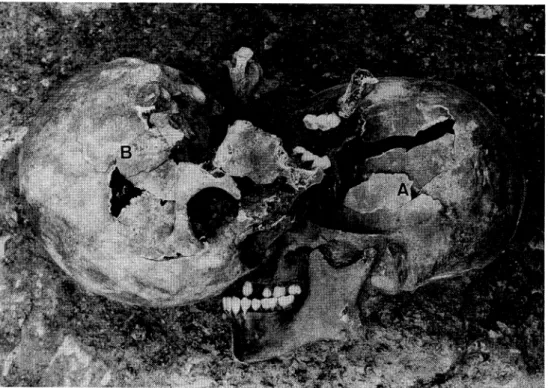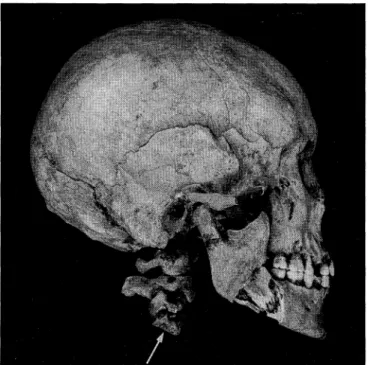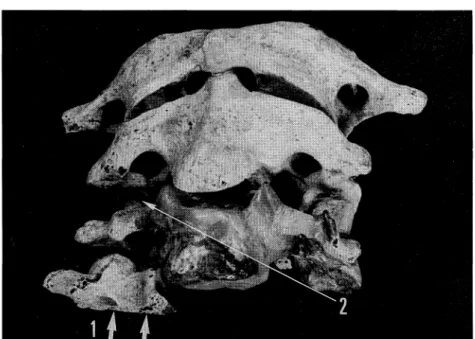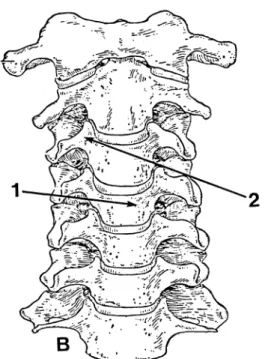Note on the Technique of Decapitation in Medieval Japan
Iwataro MORIMOTO
Department of Anatomy, St. Marianna University School of Medicine
Abstract A detailed technique of decapitation by the sword in the Middle Ages could be elucidated from the skulls with the upper cervical vertebrae of two males from Imakoji-nishi site, Kamakura, Kanagawa Pref., Japan, which dated back to the Nanbokucho or early Muromachi period, i. e. the latter half of the 14th century. The observations showed that in both males the sword cut deep into the 4th cervical vertebra from the posterior right side and came a short stop halfway in the vertebral column, followed by a secondary cut added to the 3rd cervical vertebra in a male to sever his head from the body. Old Japanese tradition said that the anterior skin of the neck of the convicted person should be left intact in decapitation. This seemed to indi-cate that the old Japanese saying and the real technique of beheading in the Middle Ages agreed with each other. In comparison with Iron Age specimens from Sutton Walls, Great Britain, it was suggested that the Japanese way of decapitation by the sword might be distinguishable from the old European by a primary clean but halfway cut deep into the neck from behind to lop the head.
Keywords Bone injury, Decapitation, Middle ages, Japanese custom
Introduction
As yet a few papers have been made of the skeletons of old-time Japanese whose head had been cut off. As far as is known, however, the decapitation is mostly supposed indirectly on the basis of a special kind of arrangement of the injuries cut by the so-called Japanese sword only in the occipital region of the skull remained. For example, KAWAGOE (1965) suggested an unwritten decapitation of a male on account of an ovoid cut located at the occipital squama
of the skull from Ginza-nishi, Chuo-ku, Tokyo, which dated back to the middle stage of the Edo period, i. e. 18th century. It was likewise mentioned by MORIMOTO
(1985) that a male would be beheaded with-out any record, considering the
arrange-ment of several injuries distributed in both occipital and temporal bones of the skull from Hitotsubashi Metropolitan High School site, Chiyoda-ku, Tokyo, dating from the early stage of the Edo period, i. e. 17th century.
Recently, the author has examined two
Materials
The skeletons examined consisted of the skulls and upper cervical vertebrae of two adult males, which dated back to the medieval Nanbokucho or early Muromachi period, i. e. the latter half of the 14th century. They were unearthed together from one and the same small pit near a gate on the premises of those days in Imakoji-nishi archaeological site, Kamakura, Kanagawa Pref., Japan (Fig. 1). In either skull, the mandible is in a natural position, though the left half of this bone of male B had been naturally broken post mortem and lost. Since the skulls with the upper cervical vertebrae were unaccompanied with any other postcranial skeletons, it seemed very likely that the heads cut off would be carelessly buried in this place after the identification of the convicted persons with neither ceremony nor returning the heads to the bereaved families. All the bones observed were in a fairly good state of preservation. The ages of males A and B estimated from both cranial suture closure and dental attrition would be in the twenties and in the thirties, respectively. No patho-logical changes except the injuries in the cervical vertebrae were found in their skeletons.
downward and forward forming an angle of about 50 degrees with a horizontal plane. The postero-inferior side of the triangular cut intersects the inferior surface of the vertebral body, making a straight line directing from the anterior right to the posterior left, while the antero-superior left side of the cut runs obliquely from the middle of the anterior surface to the left part of the inferior surface of the vertebral body, forming a straight border line between the cut surface and the successive broken area due to the impact of the sword. Judg-ing from the shape and inclination of the injured surface, the sharp edge of the sword seems to have cut deep into the vertebral body in an oblique direction from the lower posterior right to the upper anterior left, and come to a full stop around the median line, associated with the secondary breakage at an area contiguous to the cut in the anterior left part of the vertebral body. Considering both direction and inclination of the cut in the 3rd cervical vertebral body, it may safely be assumed that the sword had come through the 4th cervical vertebra obliquely from the posterior right side, though this cannot be clearly exhibited because the latter vertebra had been lost. The mandibular ramus on either side which is anteriorly and laterally opposite to the 3rd cervical vertebra in situ remains intact.
Fig, 1. Discovery of the skulls with the upper cervical vertebrae of males A (right) and B (left) buried together into one and the same pit in Imakoji-nishi site, Kamakura. By courtesy of Mr. Norikata MATSUO of the Board of Education of Kamakura City.
Fig. 2. Right lateral aspect of the skull with the 1st to 3rd cervical vertebrae of male A. The arrow shows the cut surface at the 3rd cervical vertebral body in profile.
Fig. 3. Right lateral aspect of the 1st to 3rd cervical vertebrae of male A. The long and short arrows show the cut surface and the successive broken area at the 3rd cervical body in profile, respectively.
Fig. 4. Antero-inferior aspect of the 1st to 3rd cervical vertebrae of male A. The white (No. 1) and black (No. 2) arrows show the triangular cut surface and the successive broken area at the 3rd cervical vertebral body,
(B) Male B : The skeletal remains of male B observed are composed of the skull and the 1st to 4th cervical vertebrae, though the left half of the mandible had been lost (Fig. 5). There are two kinds of cut sur-faces in the cervical vertebrae: main or primary cut in the 4th cervical vertebra and accessory or secondary one in the 3rd. The main cut is running through the right transverse and superior articular pro-cesses of the 4th cervical vertebra on a nearly horizontal plane (Figs. 5 to 7, 10 and 11). As a result, only a small part chiefly composed of the upper halves of the pro-cesses above the cut surface remains, whereas another majority of this bone is lost. Since the 4th cervical vertebra is mostly lost, it is not easy to say whether the sword stopped so short in the vertebral body or not. If, however, just the same as seen in the 3rd cervical vertebra of male A is true of the case as male B, the sharp
edge of the sword would run from the posterior right to the anterior left to cut deep into the 4th cervical vertebral body of male B, and come to a full stop halfway, causing a secondary breakage of the verte-bral body at an area contiguous to the cut surface.
The accessory cut which seems to be successively added on the neck in order to sever the head completely from the body is found in the 3rd cervical vertebra (Figs. 6, 7, 10 and 11). It runs obliquely upward and to the right from the tip of the left inferior articular process to the upper margin of the root of the right pedicle, resulting in the cleanly divided bone. On the other hand, the lamina of this vertebra is also broken by the impact of the secondary cut and lost. No injury is found in the 2nd cervical vertebra located just above the 3rd cervical vertebra in situ. The mandibular ramus on the right side likewise remains intact, though
Fig. 5. Right lateral aspect of the skull with the 1st to 4th cervical vertebrae of male B. The arrow shows the main cut at the 4th cervical vertebra in profile.
Fig 6. Anterior aspect of the 1st to 4th cervical vertebrae of male B. The short arrows (No. 1) show the horizontal main cut surface at the 4th cervical vertebra in profile, while the long arrow (No. 2) indicates the oblique secondary cut line at the 3rd, respectively.
Fig. 7. Inferior aspect of the 1st to 4th cervical vertebrae of male B. The arrows No. 1 show the main cut surface through the right transverse and superior articular processes of the 4th cervical vertebra. The arrows No. 2 indicate the secondary cut surface at the left inferior articular process of the 4th cervical vertebra, while the arrows No. 3 show the same secondary cut edge at the inferior surface of the body of this vertebra.
Fig. 8. Diagram to show the observed cut line (No. 1) which is drawn on the anterior aspect of the cervical vertebrae in the case of male A. (The skeletal sketches in Figs. 8 and 10 are based on R. MONTGOMERY, Head and neck anatomy with clinical correlations, McGraw-Hill International Book Co.,
Auck-land, 1981).
Fig. 9. Diagram to show the observed cut line (No. 1) which is drawn on the left lateral aspect of the neck in the case of male A. (The sketches of the neck in Figs. 9 and 11 are based on J. L. HIATT and L. P. GARTNER, Textbook of head and neck
my, Appleton-Century-Crofts, New York, 1982).
that on the left is lost.
Brief Note
In the skeletons of both males A and B examined, the primary cut for decapitation resulting from the sword runs equally through the 4th cervical vertebra from behind, though a secondary cut is added to the 3rd cervical vertebra of male B. It should be noticed that the primary cut is running in a direction from the postero-inferior right to the antero-superior left in male A (Figs. 8 and 9) and nearly horizon-tally from the posterior right in male B
(Figs. 10 and 11). This seems to indicate
that the neck of each beheaded person is rather in a horizontal than in a vertical position during decapitation, and that the right-handed executioner is standing on the slightly posterior left side of each crouching convicted person.
As seen in the above mentioned cases of KAWAGOE and MORIMOTO, the sword is liable to miss the executioner's aim and often to cut the head (or the shoulders) of the convicted person, first because the con-victed person sometimes makes his escape in the place of execution, and second be-cause the executioner is not unusually poor at the technique of decapitation. According to
Fig. 10. Diagram to show the observed main (No. 1) and secondary (No. 2) cut lines which are drawn on the anterior aspect of the cervical vertebrae in the case of male B.
Fig. 11. Diagram to show the observed main (No. 1) and secondary (No. 2) cut lines which are drawn on the left lateral aspect of the neck in the case of male B.
MORIKAWA (1978), it was a general method of decapitation by the sword on the execu-tion ground in the Edo period that the convicted person who was formally sitting back on his feet, with the knees on a straw-mat, was mostly decapitated his head just at the moment when his neck was reflectly extended forward because his big toes were suddenly pulled backward by the executioner's assistants. It was mentioned by MORIKAWA that as the convicted person was usually frightened on the execution ground, so the executioner rarely beheaded him without any warning in the midst of a small consolatory talk with him. Since the head had been cut off precisely at the 4th cervical vertebra in the present series, it has to be realized that the two convicted
persons would be beheaded by one and the same executioner who should be ranked with an expert or veteran in the way of decapitation of those days, and possibly that the convicted persons might be brave and dignified warriors prepared for decapitation.
As seen in Iron Age specimens from Sut-ton Walls of Great Britain reported by CORNWALL (1954) and cited by BROTHWELL
(1981), the old European decapitation by the sword is used to result in cleanly divided cervical vertebrae. The Japanese method of decapitation, however, differs from the
European in the use of the sword. The present observations make it quite clear that the sword generally cuts deep into the cervical vertebral column and stops short within it. It is, however, highly possible
that this halfway cut could put the con-victed person quickly to death, because the sword would sever not only the spinal cord, but also the right vertebral and common carotid arteries. Old Japanese tradition said that the anterior skin of the neck of the convicted person should be left intact at the time of decapitation. This method of decapitation was, according to SASAMA (1980), in common use during the Edo period (ca. 17th to 19th century) by reason of pre-venting both executioner and convict from a stain on their clothes with the blood spurted out of the beheaded body. That is, if the cut head (with upper neck) was con-nected with its counter part of the body by the skin of the anterior region of the neck, the head became to hang down forward and the blood did not spurt but flowed out steadily from the body. The author's mate-rial indicates that the halfway-cut method of decapitation had been adopted not only in the recent Edo, but also in the medieval Muromachi period of Japan. This shows that the old Japanese saying and the present observations agree with each other. It is, therefore, reasonable to suppose that the Japanese method of decapitation in the Middle Ages is distinguishable from the old European by a primary clean but halfway cut deep into the neck from behind to lop the head.
Acknowledgement
The author wishes to express his thanks to Mr. Norikata MATSUO of the Board of Education of Kamakura City for material and helpful suggestions.
抄 録 中 世に おけ る打 ち 首 の 技 法 森 本 岩 太 郎 打 ち首(斬 首)の 所 見 が 認 め られ る古 人 首 例 は 比 較 的 少 な く,偶 然 に 発 見 され た と して も,頭 蓋 の 刀 創 な ど か ら斬 首 を 間接 的 に 想 定 した 場 合 が 大 部 分 を 占 め る と 思 わ れ る.著 者 が 最 近 経 験 した 鎌 倉 市 今 小路 西 遺 跡 出 土 の 南 北 朝 期(14世 紀 後 半)に 属 す る斬 首 され た2個 体 分 の 中 世 頭 蓋 の場 合 は,切 られ た 上 位 頸 椎 が 一緒 に 残 って い た の で 打 ち 首 の 技 法 が よ く分 か る.当 時 の屋 敷 の 門 付 近 に,A・B2個 体 分 の 頭 蓋 と上 位 頸 椎 だ け が 一 緒 に 埋 め られ て い た .首 実 験 後 に首 だ け が遺 族 に 返 され ず,そ こに 仮 埋 葬 され た も の で あ る ら しい.2体 と も男 性 で,年 齢 はAが 壮 年 期 前 半,Bが 壮 年 期 後 半 と推 定 され る.頭 蓋 は 無 傷 で,そ れ ぞ れ の 頸 椎 が 日本 刀 の よ うな鋭 利 な刃 物 に よ り切 断 さ れ て い る.頭 蓋 と 第1∼3頸 椎 か らな る男 性Aの 場 合,切 断 面 は 第3頸 椎 体 の前 下 部 を 右 後 下 方 か ら左 前 上 方 へ 走 って 椎 体 の 途 中で 止 ま り,そ の 先 の 椎 体 部 分 は 刀 の 衝 撃 に よ って 破 壊 され 失 わ れ てい る.切 断 面 の走 向 か らみ て,第4 頸 椎(残 存 せ ず)を 右 後 下 方 か ら切 断 した 刃 先 が 第3頸 椎 体 に 達 して 止 ま った と思 わ れ る.頭 蓋 と第1∼4頸 椎 か らな る男 性Bの 場 合,主 切 断 面 は 第4頸 椎 の 中 央 を 右 か らほ ぼ 水 平 に 走 って い る.切 断面 よ り上 方 に あ る右 横 突 起 と右 上 関 節 突 起 の 上 半 部 だ け が残 存 し,そ れ 以 外 の 第4頸 椎 の 大 部 分 は 失 わ れ て い る.Aの 場 合 と同 様 に,刃 先 が 第4頸 椎 の 椎 体 の途 中 で止 ま って, そ の 先 の 部 分 が 破 壊 され た もの と推 定 さ れ る.別 に 第 3頸 椎 の 左 下 関 節 突 起 先 端 部 か ら右 椎 弓根 基 部 上面 へ 向 け て 椎 体 を 左 下 方 か ら右 上 方 へ 斜 め に走 る 副 切 断 面 が あ り,こ の 副 切 断 面 に よ って 改 め て首 が 切 り離 され てい る.失 わ れ た 第3頸 椎 の 椎 弓板 も この とき壊 され た と思 わ れ る.切 断 面 の 走 向 か らみ て,両 個 体 と も, 垂 直 に 立 て た 頸 部 を 横 切 りに され た とい う よ りは,む しろ正 座 の よ うな 低 い 姿 勢 を と っ て前 方 に差 し伸 べ た 頸 部 を,左 側 や や 後 方 に 立 った 右 利 き の 執 刀者 に よ り 切 り下 ろす 形 で 右 背 後 か ら鋭 く切 断 され,絶 命 した と 推 定 され る.こ の 際,首 は一 気 に 切 り落 と され て い な い.こ れ は 俗 に 「打 ち 首 は ク ビの 前 皮 一 枚 を残 す のが 定 法 」 と言 わ れ る と ころ に 近 似 の 所 見 で あ り,こ の技 法 の 確 立 が 中 世 まで さか の ぼ り得 る もの で あ る こ とが 分 か る.2体 と も最 初 に 第4頸 椎 部 を 正 確 に 切 断 さ
BROTHWELL, D. R., 1981: Digging up bones. 3rd ed. 208pp. British Museum (Natural History) / Cornell Univ. Press, New York.
CORNWALL, I. W., 1954: The human remains from Sutton Walls. Arch. J., London, 60: 66-78. (Cited by BROTHWELL).
13:79-82.雄 山 閣,東 京]
SASAMA, Y.,1980: Illustrated dictionary of
judicial and police systems and practice in Edo (old Tokyo).
[笹 間 良 彦,1980:図 説 江 戸 の 司 法 警 察 事 典,柏 書
房,東 京]
森 本 岩 太 郎 聖 マ リア ン ナ医 科 大 学 第2解 剖 学 教 室
〒213川 崎 市 宮 前 区 菅 生2-1-16
Iwataro MORIMOTO Department of Anatomy, St. Marianna University School of Medicine 2-1-16 Sugao, Miyamae, Kawasaki, Kanagawa 213, Japan





